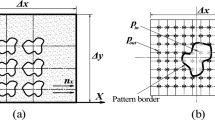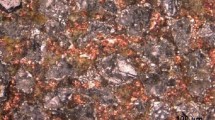Abstract
For achieving high material removal rates while grinding free formed surfaces, shape grinding with toroid grinding wheels is favored. The material removal is carried out line by line. The contact area between grinding wheel and workpiece is therefore complex and varying. Without detailed knowledge about the contact area, which is influenced by many factors, the shape grinding process can only be performed sub-optimally. To improve this flexible production process and in order to ensure a suitable process strategy a simulation-tool is being developed. The simulation comprises a geometric-kinematic process simulation and a finite elements simulation. This paper presents basic parts of the investigation, modelling and simulation of the NC-shape grinding process with toroid grinding wheels.








Similar content being viewed by others
References
Stautner M (2006) Simulation und Optimierung der mehrachsigen Fräsbearbeitung. Dissertation Universität Dortmund, Vulkan Verlag, Essen
Surmann T (2006) Geometrisch-physikalische Simulation der Prozess-dynamik für das fünfachsige Fräsen von Freiformflächen. Dissertation Universität Dortmund, Vulkan Verlag, Essen
Damm P (2006) Rechnergestützte Optimierung des 5-Achsen Simultan-fräsens von Freiformflächen. Dissertation Universität Dortmund, Vulkan Verlag, Essen
Ungemach E, Odendahl S, Stautner M, Mehnen J (2006) In-process simulation of multi-axes milling in the production of lightweight structures. In: Kleiner M et al (eds) Flexible manufacture of lightweight frame structures. Advanced Materials Research, vol. 10. TTP Trans Tech Publications Ltd, Switzerland, pp. 111–120
N. N.: DIN 8589-11, Fertigungsverfahren Spanen. Teil 11: Schleifen mit rotierendem Werkzeug. Einordnung, Unterteilung, Begriffe. Beuth Verlag, Berlin, September 2003
Hegener G (1998) Technologische Grundlagen des Hochleistungs-Außenrund-Formschleifens. Dissertation RWTH Aachen, Shaker Verlag, Aachen
Gerent O (2001) Entwicklungen zu einem ganzheitlichen Prozessmodell für das Hochleistungs-Außenrund-Formschleifen. Dissertation RWTH Aachen, Shaker Verlag, Aachen
Gehring V (1993) Numerisch gesteuertes Formschleifen von gekrümmten Werkstückoberflächen. Fortschr.-Ber. VDI Reihe 2 Nr. 299. VDI-Verlag, Düsseldorf
Okuyama S, Kitajima T, Yui A (2004) Theoretical study on the effect of form error of grinding wheel surfaces under free form grinding. Key Eng Mater 257–258:147–152
Brinksmeier E, Aurich JC, Govekar E, Heinzel C, Hoffmeister HW, Peters J, Rentsch R, Stephenson DJ, Uhlmann E, Weinert K, Wittmann M (2006) Advances in modelling and simulation of grinding processes. Ann CIRP, Vol. 55:1–30
N. N.: DIN ISO 6104, Schleifwerkzeuge mit Diamant oder Bornitrid—Rotierende Schleifwerkzeuge mit Diamant oder kubischem Bornitrid.. Beuth Verlag, Berlin, August 2005
Warnecke G, David K (2000) A modeling method for analyzing dynamic behavior of the grinding process and for predicting the stability limit. Production Engineering—Research and Development, Annals of the German Academic Society for Production Engineering, VII, 2. pp 115–120
Weinert K, Schulte M, Kötter D, Noyen M (2006) Economical and flexible profile grinding of hard alloys and hard composites. Production Engineering—Research and Development, Annals of the German Academic Society for Production Engineering, XIII, 1. pp 19–22
Weinert K, Blum H, Jansen T, Mohn T, Rademacher A (2005) Angepasste Simulationstechnik zur Analyse NC-gesteuerter Formschleifprozesse. ZWF Zeitschrift für wirtschaftlichen Fabrikbetrieb, 100 7–8, Carl Hanser Verlag, pp. 406–410
Tönshoff HK, Peters J, Inasaki I, Paul T.: Modelling and Simulation of Grinding Processes. Annals of the CIRP, Vol. 41/2/1992, pp. 677–688
Panagiotopoulos PD, Glocker C (2000) Inequality constraints with elastic impacts in deformable bodies. The convex case. Arch Appl Mech 70:349–365
Czekanski A, El-Abbasi N, Meguid SA, Refaat MH (2001) On the elastodynamic solution of frictional contact problems using variational inequalities. Int J Numer Methods Eng 50:611–627
Blum H, Jansen T, Rademacher A, Weinert K (2006) Finite elements in space and time for dynamic contact problems. Ergebnisberichte Angewandte Mathematik, Universität Dortmund, No. 322, available via www.mathematik.uni-dortmund.de/lsiii/static/ preprintfb.nhtml
Blum, H.; Kleemann, H.; Rademacher, A.; Schröder, A SOFAR. small object oriented finite element library for application and research. www.mathematik.uni-dortmund.de/lsx/research/software/sofar/index.html
Martins JAC, Oden JT (1987) Existence and uniqueness results for dynamic contact problems with nonlinear normal and friction interface laws. Nonlinear Anal Theory Methods Appl 11(3):407–428
Acknowledgments
This research work was supported by the Deutsche Forschungsgemeinschaft (DFG) within the “Schwerpunktprogramm” Prediction and Manipulation of Interaction between Structure and Process (SPP 1180). It is conducted in cooperation with Chair for Scientific Computing, University of Dortmund.
Author information
Authors and Affiliations
Corresponding author
Rights and permissions
About this article
Cite this article
Weinert, K., Blum, H., Jansen, T. et al. Simulation based optimization of the NC-shape grinding process with toroid grinding wheels. Prod. Eng. Res. Devel. 1, 245–252 (2007). https://doi.org/10.1007/s11740-007-0042-8
Received:
Accepted:
Published:
Issue Date:
DOI: https://doi.org/10.1007/s11740-007-0042-8




